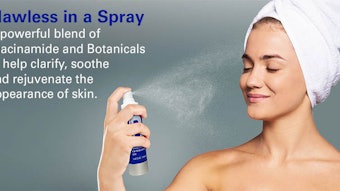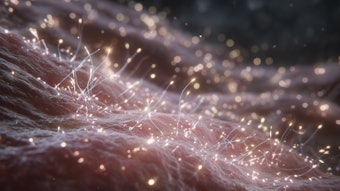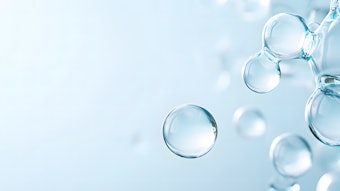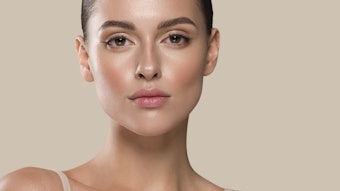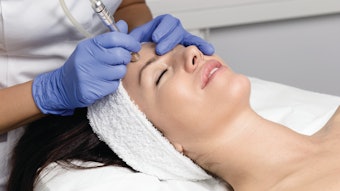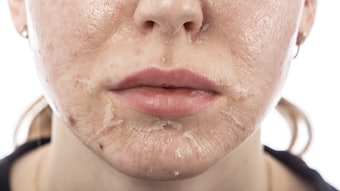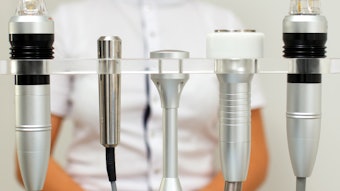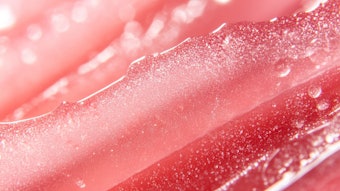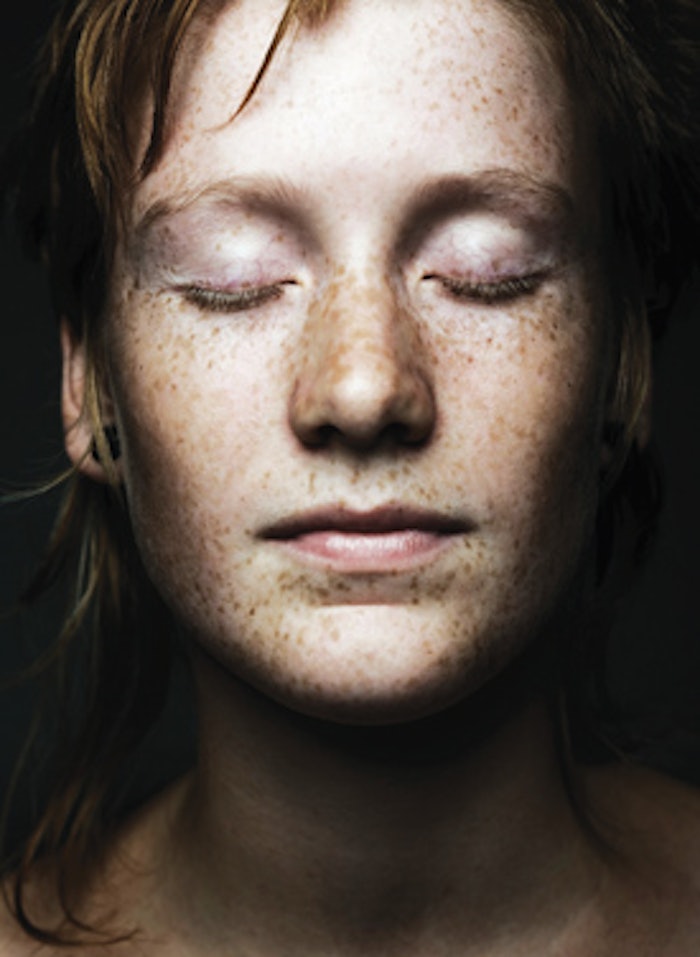
This article originally appeared in the October 2008 issue of Cosmetics & Toiletries magazine. Reprinted with permission. All rights reserved.
Irregular pigmentation of the face is one of the most common signs of photoaging. Pigmentation occurs because of the uneven production of melanin—a brown pigment produced by melanocytes—in the skin. Many different patterns can be seen on the faces of people of different ages. Small localized brown spots in the form of freckles across the cheeks, medically known as lentigenes, usually appear between the ages of 25–30 years, depending on cumulative sun exposure. Pigmentation can also present in the form of melasma, a diffuse darkening of the skin over the sides of the forehead, lateral jawline and upper lip. This type of skin darkening is hormone-dependent, and is most commonly seen during pregnancy and menopause, as well as with the use of oral contraceptives. Lastly, increased facial pigmentation can present as an overall skin darkening in people age 50 years or older due to a combination of melanin pigment and fragmented elastin fibers.
Other factors also influence facial pigmentation, such as gender. Because men do not experience the same hormonal issues, increased facial pigmentation from melasma is uncommon. The coarse skin texture of the male face from hair growth camouflages the fine freckling that is evident on the female face. Finally, the male face is more resistant to UVA damage due to its increased thickness from the terminal beard hairs that are present. UVA radiation penetrates deeply within the skin, but not as readily into thicker male skin as it does into thinner female skin. Because UVA damage is the primary cause of pigmentary abnormalities, pigment lightening products are more commonly used by females than males.
There are also racially based differences in skin pigmentation problems. Individuals who have darker skin are more prone to skin darkening. This is due to the enhanced ability of darker skin to produce melanin. Pigment may be produced in response to sun exposure, skin disease and skin trauma. It is distinctly more difficult to lighten skin in individuals with darker complexions. Although pigmentation problems may be more visible in those with lighter skin, over-the-counter (OTC) skin-lightening preparations are more successful with this population.
Methods of skin-lightening
There is no doubt that the best method of skin lightening is to avoid sun damage. In fact, all OTC skin-lightening treatments should include a sunscreen. Sunlight contains visible light, and invisible UVB and UVA radiation. Visible light and UVB radiation do not tan the skin. Skin tanning in people of all skin colors is due to UVA radiation. Most sunscreens focus on preventing sunburn, which is due to UVB radiation. They do not prevent tanning, since skin isn’t protected from UVA radiation. Thus, sunscreens selected for skin-lightening purposes should contain UVA photoprotectants such as avobenzone, oxybenzone, zinc oxide and/or titanium dioxide.
Topical treatments for facial pigmentation are problematic. A successful treatment must remove existing pigment from the skin, shut down the manufacture of additional melanin pigment and prevent the transfer of existing melanin pigment to the melanosomes. No currently available topical product is able to accomplish all three of these functions. This article examines the various actives contained in topical skin-lightening products.
Hydroquinone. The gold standard for topical skin lightening in the United States remains hydroquinone. This substance is controversial and has been removed from the OTC markets in Europe and Asia. Concern arose from reports that oral hydroquinone caused cancer in mice fed large amounts of the substance. Although oral consumption probably is not related to topical application, hydroquinone remains controversial because it actually is toxic to melanocytes. Hydroquinone, a phenolic compound chemically known as 1,4 dihydroxybenzene, functions by inhibiting tyrosine, a key substance in melanin pigment production. Specifically, it covalently binds to histidine or interacts with copper at the active site of tyrosinase. It also inhibits ribonucleic acid (RNA) and deoxyribonucleic acid (DNA) synthesis and may alter melanosome formation, selectively damaging melanocytes. These activities suppress the melanocyte, causing a gradual decrease of melanin pigment production.1
Hydroquinone is available in both the OTC and prescription U.S. markets. Although concern has arisen because of its availability, no restrictions on hydroquinone use have been issued by the U.S. Food and Drug Administration (FDA) as of this writing. Hydroquinone is a medication that received grandfather status from the FDA because it was in common use when the FDA was founded. Therefore, some hydroquinone formulations have never undergone the testing required for today’s drug approval. Many prescription products have made submissions to the FDA and completed the required safety and efficacy testing, but OTC formulations and some generic formulations were never tested. It is these untested formulations that have created concern. The maximum concentration in OTC products is 2% and most prescription formulations are 4%. In general, 4% hydroquinone is more effective than 2% hydroquinone, but neither concentration will lighten pigment that is deep in the skin because it can’t penetrate that deeply. Current hydroquinone preparations are unable to reach the middle-to-deep dermis where post-inflammatory acne pigmentation may lie; therefore, its pigment-lightening abilities are limited. Deep penetration of hydroquinone also raises unresolved safety issues. In all formulations, hydroquinone is highly unstable and turns brown on contact with air, which oxidizes the hyroquinone molecule. Once the hydroquinone has oxidized, it is no longer active and should be discarded. It would be advisable to label OTC products with a warning that brown, discolored cream is unsuitable for use.
Mequinol. With the regulatory issues related to hydroquinone, a new pigment-lightener known as mequinol has been introduced. At present, mequinol is only available by prescription, but has been approved for use in the United States and Europe. It is chemically known as 4-hydroxyanisole and is chemically synthesized. Other names include methoxyphenol, hydroquinone monomethyl ether and p-hydroxyanisole. Mequinol is available in the United States in a 2% concentration and is commercially marketed as a prescription skin-lightener in combination with 0.01% tretinoin as a penetration enhancer; vitamin C in the form of ascorbic acid; and ascorbyl palmitate, to enhance skin lightening. These active agents are dissolved in an ethyl alcohol vehicle. It is unknown exactly how mequinol lightens skin, but it is a competitive inhibitor in the formation of melanin precursors. It does not damage the melanocyte like hydroquinone.
Retinoids. Many dermatologists combine hydroquinone with prescription vitamin A formulations, such as tretinoin, to improve skin-lightening results. Tretinoin has an effect on skin pigmentation as seen by a decrease in freckling.2 Freckling is created by the irregular grouping of melanocytes,3 which can be normalized with retinoids through alterations in pigment transfer.4 Although this effect is more dramatic with topical prescription tretinoin, topical OTC retinol has been thought to provide similar effects.
Retinoids, such as retinol or retinaldehyde, can also be used as penetration enhancers for other skin-lightening agents. Ingredient combinations where each ingredient affects a different portion of the skin pigmentation pathway may be more beneficial for skin-lightening than single-ingredient formulations. Because there are many steps in pigment formation, skin lighteners can interrupt melanin production and transfer at multiple sites. Formulations that have activity at multiple sites have a better chance of stopping pigment production.
Ascorbic acid. Ascorbic acid, also known as vitamin C, is used in OTC pigment-lightening formulations. It interrupts the production of melanin by interacting with copper ions to reduce dopaquinone, an important intermediate in pigment production.5 It is a potent antioxidant that is sometimes combined with hydroquinone to prevent oxidation of the hydroquinone. By itself, low-concentration ascorbic acid is a poor skin-lightening agent. In higher concentrations, ascorbic acid can be a strong skin irritant due to its low pH, but may induce pigment-lightening by providing skin peeling in lighter-skinned individuals. High concentrations of ascorbic acid must be avoided in people of color, because the irritation paradoxically will darken the skin.
Licorice extract. Licorice extracts are used in many OTC products to lighten skin. The active agents are liquiritin and isoliquertin, which are glycosides containing flavenoids.6 Liquiritin induces skin-lightening by dispersing melanin pigment and enhancing more even pigment distribution. It must be applied to the skin in a dose of 1 g/day for four weeks in order to see a clinical result. This may not be practical in OTC formulations because of the expense of such a high concentration. Because the liquiritin is an anti-inflammatory, irritation is not a side effect with licorice extract, unlike with hydroquinone, retinoids and ascorbic acid, where irritation is the dose-limiting problem.
Alpha lipoic acid. Alpha lipoic acid is found in some OTC pigment-lightening preparations. It is a disulfide derivative of octanoic acid, which is able to inhibit tyrosinase, a key enzyme in pigment production. However, its ability to lighten skin is doubtful, because it is a large molecule with questionable penetration to the level of the melanocyte where tyrosinase is present. Effective pigment-lightening agents must reach their target in order to induce the desired effect. Molecular size and molecular charge are two key considerations in pigment-lightening efficacy.
Kojic acid. Kojic acid, chemically known as 5-hydroxymethyl-4H-pyrane-4-one, is one of the most popular skin-lightening agents found globally in OTC skin-lightening creams. It is a hydrophilic fungal derivative obtained from the aspergillus and penicillium species. It frequently is employed in Asia for the treatment of melasma.7 Some studies indicate that kojic acid is equivalent to hydroquinone in pigment-lightening results.8 The activity of kojic acid is attributed to its ability to prevent tyrosinase activity by binding to copper. The problem with kojic acid is again the ability to penetrate the skin and reach its copper target. It is possible that penetration-enhancers might overcome some of this difficulty; however, damage to the skin barrier and product irritation are common side effects.
Aleosin. Aleosin is a botanical low-molecular-weight glycoprotein obtained from the aloe vera plant. It is a natural hydroxymethylchromone that functions by inhibiting tyrosinase.9,10 In contrast to hydroquinone, it shows no cell cytotoxicity; however, it has a limited ability to penetrate the skin due to its hydrophilic nature. It is sometimes mixed with arbutin, described below, to enhance its skin-lightening abilities.
Arbutin. Arbutin is obtained from the leaves of the Vaccinium vitis-idaea (lingonberry) and other related plants. It is a naturally occurring gluconopyranoside that causes decreased tyrosinase activity without affecting messenger RNA expression.11 It also inhibits melanosome maturation. Arbutin is not toxic to melanocytes and is used in a variety of pigment-lightening preparations in Japan at concentrations of 3%. Higher concentrations are more efficacious than lower concentrations, but a paradoxical pigment-darkening may occur due to skin irritation. Synthetic versions of arbutin, such as deoxyarbutin, may offer enhanced efficacy.
A client need
Skin-lightening is a definite challenge. Many substances have been reported to inhibit melanin production in vitro but these same results are not seen in vivo. Melanocytes are extremely difficult cells to grow in culture, and it is possible that many skin-lightening ingredients that did not produce clinical results were toxic to the cultured melanocytes. It is important that skin-lightening ingredients only suppress pigment production and do not destroy the melanocytes. Melanocyte destruction results in permanent skin-lightening, which must be avoided at all costs. Melanocytes are present at birth, and do not divide or reproduce during an individual’s lifespan, making cell-preservation extremely important. Furthermore, cell cultures do not have the stratum corneum barrier to prevent penetration of skin-lightening ingredients. For a pigment-lightening preparation to be effective, it must reach the melanocyte deep within the skin. This is the limiting factor in most skin-lighteners.
There is no doubt that pigment-lightening will be a client need that continues to grow during the next decade. Attractive, youthful skin is even in color without discrete areas of darkening. Sun avoidance is the best preventive measure, but the human desire to seek the sun, especially during youth, will make skin-lightening a challenge that must be overcome.
REFERENCES
1. RM Halder and GM Richards, Management of dischromias in ethnic skin, Dermatol Ther 17 151–157 (2004)
2. GD Weinstein, TP Nigra and PE Pochi et al, Topical tretinoin for treatment of photodamaged skin, Arch Dermatol 127 659–665 (1991)
3. BA Gilchrest, FB Blog, and G Szabo, Effects of aging and chronic sun exposure on melanocytes in human skin, J Invest Dermatol 73 141–143 (1979)
4. J Bhawan, AG Serva, and K Nehal et al, Effects of tretinoin on photodamaged skin a histologic study, Arch Dermatol 127 666–672 (1991)
5. LE Espinal-Perez, B Moncada, and JP Castanedo-Cazares, A double blind randomized trial of 5% ascorbic acid vs 4% hydroquinone in melasma, Int J Dermatol 43(8) 604–607 (2004)
6. M Amer and M Metwalli, Topical Liquiritin improves melasma, Int J Dermatol 39(4) 299–301 (2000)
7. JT Lim, Treatment of melasma using kojic acid in a gel containing hydroquinone and glycolic acid, Derm Surg 25 282–284 (1999)
8. A Garcia, JE Fulton, Jr., The combination of glycolic acid and hydroquinone or kojic acid for the treatment of melasma and related conditions, Dermatol Surg 22(5) 443–447 (1996)
9. S Choi, SK Lee, and JE Kim et al, Aloesin inhibits hyperpigmentation induced by UV radiation, Clin Exp Dermatol 27 513–515 (2002)
10. K Jones, J Hughes, M Hong et al, Modulation of melanogenesis by aloesin: a competitive inhibitor of tyrosinase, Pigment Cell Res 15 335–340 (2002)
11. I Hori, K Nihei, I Kubo, Structural criteria for depigmenting mechanism of arbutin, Phytother Res 18 475–469 (2004)
